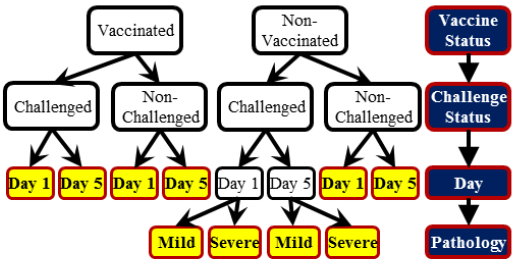



Gene Expression Differences in White Blood Cells after <em>E. coli</em> Infection in Chickens
The genes and pathways identified in this microarray study form the basis for understanding host response to avian pathogenic Escherichia coli (APEC) infection and may lead to targets for genetic improvement of resistance to disease, according to Erin Sandford, Megan Orr, Xianyao Li, Huaijun Zhou, Timothy J. Johnson, Subhashinie Kariyawasam, Lisa K. Nolan, Peng Liu and Susan J. Lamont in a report published in Iowa State University Animal Industry Report 2012.Summary and Implications
Avian pathogenic Escherichia coli (APEC) infections are detrimental to the poultry industry. White blood cells (WBC) are important in the fight against infection.
Global gene expression of WBC in response to APEC infection was measured by microarray. A large number of differences in expression were detected between chicks with a severe response to infection and chicks with either a mild response or non-challenged chicks. A large number of immune response genes including receptors and antibacterial genes experienced expression differences.
The genes and pathways identified in this microarray study form the basis for understanding host response to APEC infection and may lead to targets for genetic improvement of resistance to disease.
Introduction
APEC infections result in welfare issues for producers and losses of millions of dollars of production. The pressure to reduce use of antibacterial drugs in farm animals requires greater reliance on genetics for disease resistance. Very little is currently known about how the chicken responds to APEC infection. Microarray technology allows for the assessment of expression levels of thousands of genes, allowing for new insight into response to infection.
Materials and Methods
Commercial male broiler chicks were purchased at one day of age. At two weeks of age, chicks were either vaccinated or non-vaccinated against APEC. At four weeks of age, chicks were either challenged or non-challenged with APEC. At one and five days after challenge, blood was collected, chicks euthanised and internal lesions scored to assign pathology. Non-vaccinated, challenged chicks were split by pathology, designated by mild or severe lesions. This created ten unique groups (Figure 1).

White blood cells were isolated from collected blood and RNA isolated from four replicates of the 10 groups, 40 samples in total. Global gene expression was assessed by microarray analysis. A linear mixed model was used to calculate P values for each contrast. P values were converted to q values to control the rate of false positives. Genes were declared significant at a q value <0.05.
Results and Discussion
Five contrasts saw significant different expression between treatment groups (Table 1). Most of these contrasts involved the chicks with severe pathology.
Vaccination did not significantly impact gene expression, but was able to reduce observed lesions significantly. Many genes related to immune response were found to be significant. In the contrast between pathologies, several immune receptors, Toll-like receptors and cytokine receptors, were more highly expressed in the severe pathology. The avian beta-defensin gene family, antibacterial genes, was only significant between the severe pathology and the non-vaccinated, non-challenged group on day 1, with greater expression in the severe pathology.
| Table 1. Number of significantly differentially expressed genes between treatment groups (q value < 0.05). | |
| Contrast | Number |
|---|---|
| Non-Vaccinated, Challenged Severe Day 5 vs. Non-Vaccinated, Challenged Mild Day 5 |
1914 |
| Non-Vaccinated, Challenged Severe Day 5 vs. Non-Vaccinated, Challenged Severe Day 1 |
107 |
| Non-Vaccinated, Challenged Severe Day vs. Non-Vaccinated, Non-Challenged Day 1 |
1097 |
| Non-Vaccinated, Challenged Severe Day 5 vs. Non-Vaccinated, Non-Challenged Day 5 |
506 |
| Vaccinated, Challenged Day 1 vs. Non-Vaccinated, Non-Challenged Day 1 |
7 |
Greater knowledge about how the host responds after infection can form the foundation for targeted gene studies. These results demonstrate the importance of pathology in gene expression responses in WBC.
Further Reading
| - | You can view other reports in the ISU Animal Industry Report 2012 by clicking here. |
February 2012








